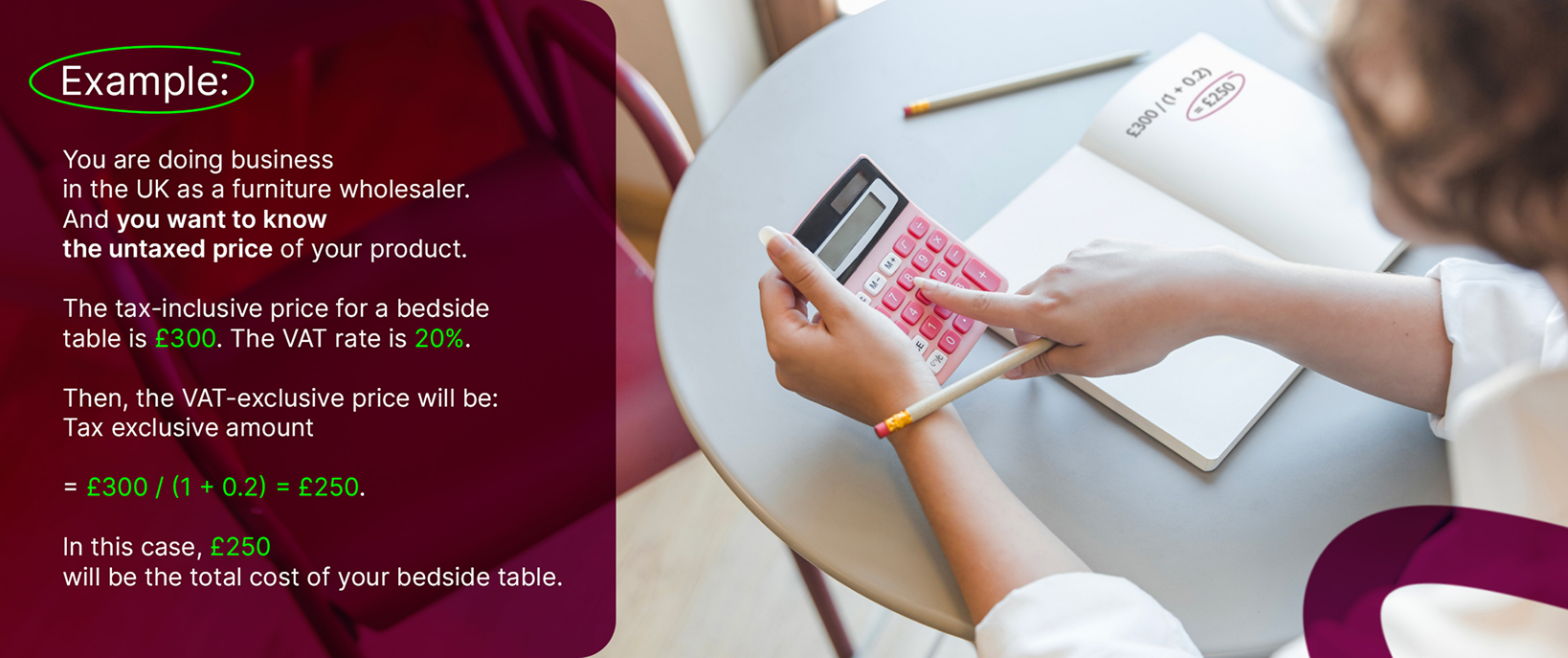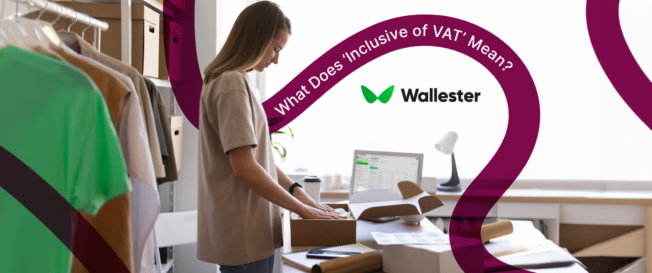Business decisions depend mainly on calculation accuracy. If a company sells goods and services, knowing the ultimate cost of a unit is crucial. Dealing with the value-added tax (VAT) or goods and services tax (GST) in your business implies using its rate in the price tags of your shop. Then you would like to know more about the term VAT and inclusive of VAT meaning in particular.
In this article, we describe VAT-inclusive and VAT-exclusive concepts and explain how to correctly calculate a product’s pre-tax and selling prices.
Overview
Business owners must know any specifics considering VAT-inclusive prices and GST-exclusive rates to be aware of the company’s profitability. Each pricing method gives clear information about inclusive and exclusive tax rates and the costs of goods or services. Shortly, all you need to know is that:
- A VAT-inclusive rate implies that GST is included in the price of goods (e.g., in retail stores).
- A term VAT exclusive means that businesses don’t include this indirect levy in the cost of units. Nevertheless, the amount of VAT charged by retailers will appear in an invoice later.
- Your company will pay taxes at VAT-inclusive and VAT-exclusive rates anyway.
Tax Methods Explained
There are three typical taxation methods that governments predominantly use globally:
- taxes imposed on assets
- taxes imposed on sales
- and taxes imposed on income.
Sales taxes should be included in the price of goods or services. In other words, they’re a consumption levy. Goods consumers will be virtual payers of GST and sales tax. A shown price represents the actual cost of a product for them.
The VAT stands for an indirect toll, implying that the price includes a specific rate (percentage). The value-added tax (VAT) is popular in the EU and the UK, while the sales tax rate is standard in the USA. The VAT rates differ depending on the country. However, some businesses conduct certain activities and, as a result, pay these taxes:
- in a flat rate;
- with zero rate;
The table below shows similar examples of VAT rates for the UK.
| Economic activity to which the toll is referred | Rate name | Rate, % |
| Most activities | Standard rate | 20% |
| Some activities, e.g. home energy and child seats in cars | Reduced rate | 5% |
| Some types of financial, insurance and social services, such as child food and clothing | Zero rate | 0% |
It is worth noting that there are also activities that are not subject to GST (e.g., certain types of public services). Organisations engaged in such activities differ from companies with a standard rate, zero VAT rate and reduced rate. They do not use this indirect levy in their calculations at all. At the same time, a business registered with a zero sales tax rate includes a tariff on the cost of production.
You can be a VAT-registered company in the UK if your turnover reaches £85,000 in 12 months. Registration is not obligatory from the very start of the firm unless you are a public entity that needs to inform every stakeholder about everything you do in your business.
A company pays the GST to HM Revenue & Customs (HMRC) in the UK or another government institution in your country. Depending on the laws in your area, the payment period could be a month, quarter, half a year, or year.
A VAT-registered firm can reclaim the tax paid to raw materials and equipment suppliers. So, considering this indirect levy, it’s a two-way street: from businesses to tax authorities and from tax authorities to firms.
Why VAT is Important?
Value-added tax is a significant source of replenishing a country’s coffers. It is a buyer’s toll, meaning buyers pay more than businesses producing goods.
International sales can be versatile in terms of inclusive and exclusive taxes. Each country has its own VAT-inclusive and VAT-exclusive models. For instance, the GST in France is 17%, Germany has a 19% rate, and the UK’s and Northern Ireland’s rates range from 5% to 20%. That is why organisations conduct all international trade primarily with VAT-exclusive prices.
VAT tax is indirect. Consequently, an entity doesn’t need to pay it in a way similar to income tax, which is direct. Their tax liability, considering VAT transactions, is a separate line in financial reports. Why? Companies that buy and sell products may ask the government for reimbursement for the tax amount.
In some cases, businesses receive a GST offset when they buy products for their use. They collect information from each purveyor’s invoice to be eligible for a refund. However, income tax regulations don’t usually allow businesses to ask for a reimbursement.
VAT works for the greater good of education, healthcare, defence and other vital state sectors.
A sales tax can motivate consumers. They must pay taxes to buy a particular product. However, consumers may cut spending on goods when they see the true cost.
What Does VAT Inclusive Mean?
The definition of the term VAT-inclusive is simple. When you see a VAT-inclusive price, the GST is already included in the price of a unit. Customers need to pay the final cost (VAT-inclusive price). Tax-inclusive prices inform them that they don’t have to pay additional tax. Most of these cases apply to shopping centres to notify consumers. Customers benefit from that, which makes their purchase experience smoother.
Let’s show it in the following example. For instance, Peter buys products in the nearest retail store. The cost of the unit is £100. It refers to VAT-inclusive prices. The standard rate of this levy is 20%. He doesn’t need to pay extra cash at the till because the sum of the toll is already included in the price. In this case, the VAT amount will be £20.
Here is another example. You are a business owner who needs to calculate the tax-inclusive price. For a more accessible demonstration, we present the VAT-inclusive price formula here:
The tax-inclusive amount = Total Costs * (1 + The VAT rate in decimals)
Example:
A company in the European Union sells shoes. One shoe costs €40, and the VAT rate is 17%. Thus, the unit selling price is €40 * (1 + 0.17) = €46.80. Consumers see this displayed price (€46.80) in an outlet store or website.
Essential Elements of Tax Inclusion
- The cost of goods and services is higher after toll inclusion.
- Customers pay according to a flat rate.
- The unit purchase price will be lower before you add a GST.
- A levy is included in the cost. The VAT will be added to the total cost of the goods before they appear on the store’s shelves.
What Does VAT Exclusive Mean?
For tax-exclusive pricing, a consumer must pay the GST at the final stage of the transaction. VAT-exclusive prices can benefit enterprises that want to simplify their cost calculation without mixing them with sales tax rates. Using such a method also makes it easier to issue an invoice. A price includes tax so that managers can analyse sales results more precisely. Incorrect information can lead to underestimated costs and losses.
Business owners must inform customers if GST is not included in the price of the goods. Such a price is a pre-tax selling price. This pricing method may interest VAT-registered companies, which may be entitled to apply for a VAT-charged refund.
If you need to convert a tax-inclusive price into an untaxed one, apply the following formula:
The VAT-exclusive price = The VAT-inclusive price / (1 + The VAT rate in decimals)

Example:
You are doing business in the UK as a furniture wholesaler. And you want to know the untaxed price of your product. The tax-inclusive price for a bedside table is £300. The VAT rate is 20%. Then, the VAT-exclusive price will be:
Tax exclusive amount = £300 / (1 + 0.2) = £250.
In this case, £250 will be the total cost of your bedside table.
Essential Elements of Levy Exclusion
- Add GST at the final stage of the transaction.
- The value of the goods goes without sales tax.
- The levy is separated when you receive a bill.
- A tax may not be included in the cost calculations.
The Main Differences Between Tax Inclusive vs. Untaxed
VAT-inclusive and VAT-exclusive pricing have apparent distinctions. The inclusive tax rate is always higher than the exclusive rate. A VAT-inclusive price involves adding a levy to the unit cost. The VAT-exclusive rate doesn’t include GST, which the retailer should add.
The unit price excluding VAT is usually lower than the price tag including VAT. This difference increases when the total amount rises. Consequently, taxes also increase when the costs of goods or services increase.
A tax-inclusive rate is helpful for consumers because they don’t need to pay additional taxes for items on the shelf. VAT-exclusive rates help businesses calculate costs, analyse production costs, and claim GST reimbursements.
Knowing these differences assists company management in sales analysis, manufacturing planning, and other pricing issues. VAT-exclusive prices help predict the costs of goods, and inclusive VAT rates provide information about future retail centre sales.
Key takeaways: VAT-inclusive
The price, including VAT, is the levy you pay to the government. It indicates the sum customers need to pay for your goods and services. The cost, exclusive of GST, is the total cost of a unit without adding indirect taxes to it.
Consumers should know whether the price is tax-inclusive or untaxed to make proper buying decisions.
Accounting software automatically generates income or expense reports with or without VAT, depending on the settings. Consider Wallester business solutions and calculate VAT and expenses correctly.


